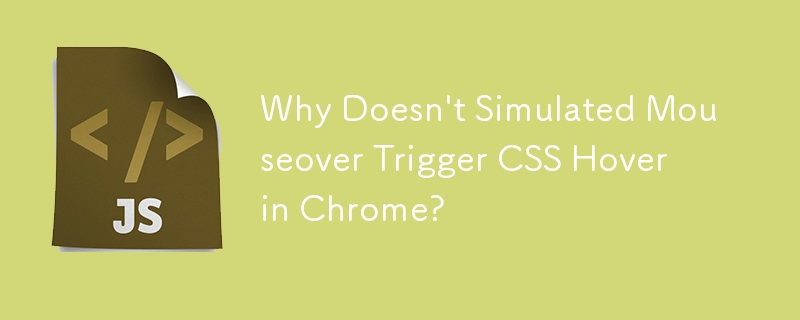Home >Web Front-end >JS Tutorial >Why Doesn\'t Simulated Mouseover Trigger CSS Hover in Chrome?
Why Doesn\'t Simulated Mouseover Trigger CSS Hover in Chrome?
- Mary-Kate OlsenOriginal
- 2024-11-02 21:26:02634browse

Simulating Mouseover in JavaScript: Clarifying Discrepancies and Implementing Manual Control
While attempting to simulate mouseover events in Chrome, you may have encountered an intriguing issue. Despite the fact that the "mouseover" event listener is successfully activated, the corresponding CSS "hover" declaration does not take effect. Additionally, attempts to modify the element's class list using classList.add("hover") within the mouseover listener also fail to trigger the desired CSS changes.
The key lies in understanding the distinction between trusted and untrusted events. According to the browser's security protocol, certain events originating from user interaction or DOM modifications are considered trusted, while those initiated by JavaScript are classified as untrusted. Hover events fall into the latter category.
Due to their untrusted nature, hover events cannot directly trigger predetermined CSS actions. This is a protective measure intended to prevent malicious scripts from modifying critical aspects of the page's behavior.
Therefore, to achieve the desired hover effect with JavaScript, an alternative approach is required. Instead of relying on the native hover event, you can manually add and remove a custom class (e.g., "hover") when the mouseover and mouseout events occur. This will enable you to control the CSS changes associated with the "hover" state yourself.
The above is the detailed content of Why Doesn\'t Simulated Mouseover Trigger CSS Hover in Chrome?. For more information, please follow other related articles on the PHP Chinese website!
Related articles
See more- An in-depth analysis of the Bootstrap list group component
- Detailed explanation of JavaScript function currying
- Complete example of JS password generation and strength detection (with demo source code download)
- Angularjs integrates WeChat UI (weui)
- How to quickly switch between Traditional Chinese and Simplified Chinese with JavaScript and the trick for websites to support switching between Simplified and Traditional Chinese_javascript skills

